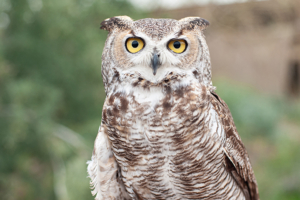Great Horned Owl – Kelvin
Name: Kelvin – Male
Species: Great Horned Owl
Liberty Arrival: 2023 / Fledgling
Injury/Condition: Right wing fracture
Kelvin was found on the ground as a fledgling with a fractured radius/ulna to his right wing. Surgery was performed to help correct the fracture. The bone healed well, however, the elbow had a loss of range of motion, making long distance flight difficult. Due to his inability to fly long distance, he was deemed non-releasable.
Great Horned Owl Facts
Description: The Great horned owls are one of largest owls and are well known for the feather tufts on top of their heads. These Owls are mottled grayish brown, with reddish brown faces and a white patch on the throat. Their overall color tone varies regionally from sooty to pale.
Habitat: Great horned owls live in woods, particularly young woods interspersed with fields or other open areas. They have a broad range of habitats including deciduous and evergreen forests, swamps, desert, tundra edges, and tropical rainforest, as well as cities, orchards, suburbs, and parks.
Range: The great horned owl is found in North and South America from northern Alaska and Canada through Mexico to the tropical rainforest to Tierra del Fuego. It is one of the most widespread and common owls in North America.
Life span: Great horned owls can live more than 12 years in the wild, with the oldest known wild great horned owl who reached 28 years old. Captive birds can easily live well into their 20’s and 30’s.
Prey: The owl’s diet consists of a wide variety of prey from raccoons, rabbits, squirrels, mice, snakes, insects, geese and other birds to the occasional cat or small dog. One of its favorite foods is the skunk, a slow-moving crepuscular animal with a large white stripe down its back like a neon sign that says, “Eat me!”.
Nests: Great horned owls do not build nests and either take over abandoned nest of a hawk or other large birds or will simply lay the eggs in alcoves, tree hollows, abandoned buildings or even on the ground.
Babies: Great Horned owls lay 2 – 3 eggs in a clutch. Babies hatch after 30 – 37 days. Youngsters fledge (learn to fly) around 9 – 10 weeks.


